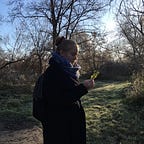The Eternal Haiku
Interpreting the symbolic meaning of “The Old Pond” by Matsuo Basho
The old pond-
a frog leaps in,
sound of water.
One is a static image of an old pond. The second one is a dynamic image of a frog jumping into the pond. At last, there is an auditory image presenting the sound that is generated from a leaping frog. Here is the scheme of how I would describe the scene depicting above:
Nothing —> action —> sound
The sound here is a consequence of an action.
‘Sound of water’ feels so intense to me here. Probably because literature is able to capture this moment, unlike fine art as an artist can’t depict the sound. If you saw the painting with ripples on the surface, would you think about the sound of the act? We shouldn’t forget about its presence.
The reason why this is a magnum opus to me is that it is not just a story about the frog and her movement. It touches upon the eternal meaning that may be found in dozens of examples. The scheme that I have found is like a skeleton capable of explaining the essence.
The main idea that can be found here is that actions echo.
Everything is impactful. I know the idea of the sequence of events seems to be explicit because this is how everything in the world works. But here it is absolutely purified of unnecessary details that it allows seeing the simplicity. Although it is so little words and motions, the power of the haiku is huge and lasting.
In this regard, the story presents the significance of not breaking the words into units. This is the power of poetry. This is like water because you feel the flow.
Another importance is pauses. The pause is a temporary interruption during the speech. This is a void that stresses the action by bringing the emptiness. It needs to make a pause after each line of the haiku.
Fewer words make each brighter and stronger.
This is also about appreciation. We can juxtapose the piece with the historical context. Envision being in the 17th century in Japan. The time when the whole music that could be produced was life-performed. More silence. Bigger distances. Brighter color. The time when rest was according to the term — rest as non-activity.
I feel serenity. I think about threes, especially Sakura, or cherry blossom, with its branches going up. Light wind.
Contradiction to the lives we are living. The more you are into modern stimulation and entertainment, the more you will need it in the future to be amused. It was the time when a leaping frog could be easily noticed. The specific state of mind was able to fix this moment for the future and for us reading it now.
I’m thinking about the person’s condition, observing the sequence of these actions. I experienced a similar state and can describe it as following. It is a capturing moment when your mind is into slight obliviousness while nothing is going on, and you are so calm, and then little motion catches your attention. Eyes are just following the motion without much consciousness.
When you have less, you appreciate more. I wish you a beautiful arrival of spring.
